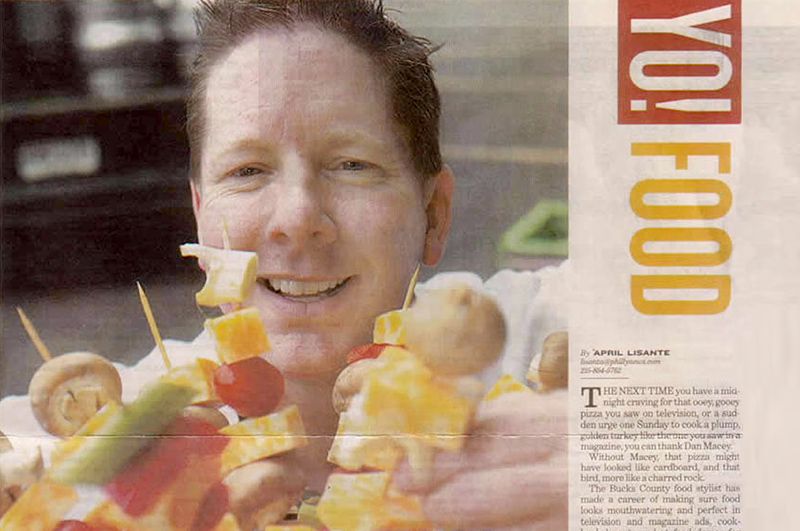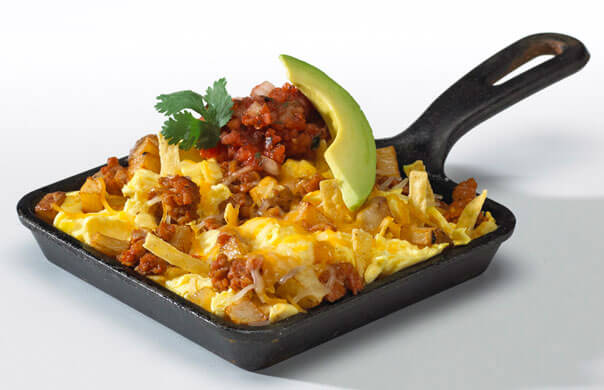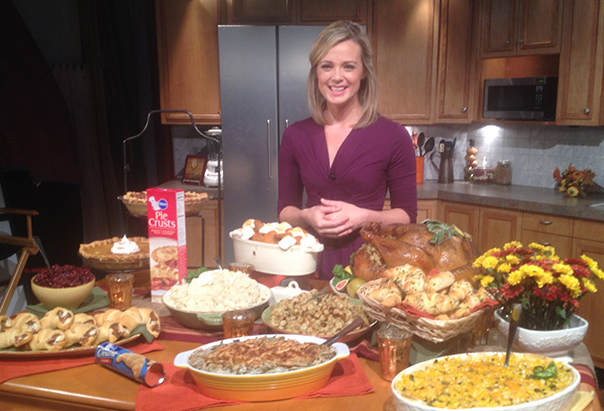Victual Reality: Yo Food

Dan Macey used to cover Enron, now he discovers the beauty in food.
The next time you have a midnight craving for that ooey, gooey pizza you saw on television, or a sudden urge one Sunday to cook a plump, golden turkey like the one you
saw in a magazine, you can thank Dan Macey. Without Macey, that pizza might have looked like cardboard, and that bird, more like a charred rock.
The Bucks County food stylist has made a career of making sure food looks mouthwatering and perfect in television and magazine ads, cookbook layouts and at food demos for QVC and “Live with Regis and Kelly.” Macey happened into this quirky career purely by chance. He scrapped his job as a magazine business writer covering Enron and other stories to take a job writing about food, then a job helping plate food for a friend’s television shoot. And in just a few years, the self-taught New Hope food artist has turned arranging cornflakes in a bowl into a full-time gig, working as a freelance stylist for pros like Lidia Bastianich, Emeril Lagasse, Tyler Florence, as well as dozens of cookbook authors and food companies.
“I’d have breakfast with Ken Lay and Jeff Skilling [of Enron scandal fame] every now and then, and I was writing about all this business stuff and realized didn’t like what I was writing about. With food styling, it’s fun. No day is ever the same.”
-Dan Macey
After talking with Macey, it’s hard to look at pizza, cereal or soft drinks in quite the same way again.
So how did you get started in the food-styling business?
Pam Anderson. She was editor of Cooks Illustrated, and I got food-writing jobs. Then I started writing for a food-business magazine that folded. In the meantime, someone I knew put out a cookbook and she needed someone to help prepare food on QVC. So I started working with her. Eventually, I started working with other people out of QVC and was under contract with HarperCollins, for anyone who sold their cookbook on QVC. I would do the food styling for them.
What are you doing now?
Now I do a lot of freelance jobs and I do a lot of satellite-media tours, where a cookbook author or television [chef] personality will make some recipes from their book and appear on a variety of stations across the country for three- or four-minute segments one morning, like say, “Good Morning Atlanta,” via satellite. I prepare the food. You have to swap things out very quickly [to keep foods looking fresh] and you have to have enough ingredients to do whatever they have to do numerous times. Most times you only have moments [between segments] so you have to have at least four things ready in a row. You have to be ready for anything to happen.
Can these superstar chefs be hard to deal with?
I’ve worked with most of the Food Network personalities. Emeril [Lagasse], Jacques Pepin, Alton Brown. Most of the time, it’s a matter of you dealing with their agency. Sometimes we have to run out at the crack of dawn to replace an ingredient. Like one time Jacques Pepin did not want to use canned corn.
Why do pro chefs need you?
Well, you really have to think like the cameras, and that’s the problem tramadol feedback when there are chefs involved. They say, “We don’t need to hire a food stylist,” but the chef is looking at the food the way it would look in a restaurant, at 360 degrees. But with a camera, you have to think about where the camera is – in the front. You don’t care what it looks like in the back. You really want to see what the ingredients are, especially if it’s for a client who is, say, selling cheese. Like a quesadilla, everything is usually inside, you have to get the cheese outside. Somehow, you have to get the message across of what’s inside. Or if it’s a lemon cheesecake, you need lemon peels on it, or the same thing with coffee, put coffee beans there so your mind jumps to what the ingredients are. I never garnish with something if it’s not an ingredient in the dish.
I’ve heard sometimes in cereal commercials, they use glue instead of milk, and other tricks like that. What are some of the secret tricks of the trade?
There actually are rules. If you are selling milk, you can’t use glue. But if it’s cereal you’re selling, sometimes I use mashed potatoes for milk. You stick cornflakes in the mashed potatoes and put a tiny bit of milk at the top.
And grill marks on meats generally are not made on a grill because most of the grills are dirty and sticky, so you use an electric branding iron. You put that on whatever it is. It makes the perfect grill marks. Or when I’m cooking turkey, if a turkey is cooked to the right time, it would be way too dark for the camera. You need to parcook the turkey, then stuff it with newspaper so it looks plumper. With the skin, I have pins [I use] to pull skin as tight as I can, then I pin the skin from the bottom so the turkey doesn’t shrivel.
And there are coloring agents you can use to make the turkey brown, like Kitchen Bouquet. Or with pizza crusts, using maltose will brown the bread without burning it. If you look on camera, it looks cooked but in fact it isn’t.
One time I prepared an Absolut vodka drink that had ice cream and orange soda in it. The ice cream makes it very foggy, so we used fake ice cream made with corn syrup, Crisco and confectioners’ sugar. You could see right through the glass.
Are these tricks your own spur-of-the-moment inventions?
I belong to the International Association of Culinary Professionals, and there’s a subsection of food stylists, about 250 of us, and we trade secrets.
What was your toughest job?
When someone calls you and says, “I just need this,” that’s always a big clue. The “just” is never “just.” Pizzas are hard. To get that piece with the cheese pulling out, it’s hard. I did [a pizza shoot for a store in] Rehoboth [Beach], Delaware, and the owner had a very specific way he wanted it to be done. I said, “No, you have to put the [raw] cheese on the pizza, then use a wallpaper remover to heat the cheese quickly and pull it apart.”


